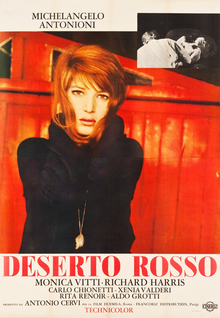Red Desert (film)
| Red Desert (Il Deserto Rosso) | |
|---|---|
 original italian film poster | |
| Directed by | Michelangelo Antonioni |
| Written by | Michelangelo Antonioni Tonino Guerra |
| Produced by | Antonio Cervi |
| Starring | Monica Vitti Richard Harris |
| Cinematography | Carlo Di Palma |
| Edited by | Eraldo Da Roma |
| Music by | Giovanni Fusco Vittorio Gelmetti |
| Distributed by | Rizzoli (USA) |
Release dates | |
Running time | 120 min |
| Country | Italy/France |
| Language | Italian |
Red Desert (Italian: Il deserto rosso) is a 1964 Italian film directed by Michelangelo Antonioni. It was written by Antonioni and Tonino Guerra and stars Monica Vitti, Richard Harris and others. It is Antonioni's first color film. The working title was Celeste e verde ("Pale blue and green"). [1] Il deserto rosso was awarded the Golden Lion at the 25th Venice Film Festival in 1964.
Plot
A young, mentally distressed woman, Giuliana (Monica Vitti), has attempted to take her life. Although she is married to Ugo (Carlo Chionetti), a plant director, and has a young son, she feels estranged from her relatives and disconnected from the world that surrounds her. She does not know how to connect to it and feels that something is terribly wrong. Ugo's friend Zeller (Richard Harris), who came to Ravenna to make a business deal, pursues her attracted by her beauty and enigma. He begins to understand her troubles better than her preoccupied husband, but it is still not enough.
Cinematography

The story is set in the industrial area of Ravenna full of huge cold factories and machines, and a polluted river valley. The visuals are dominated by pastel colors and cold whiteness with smoke and fog covering everything, and the sound design by repetitive ghostly ship horns and atmospheric electronic score. Prior to making his first color film, Antonioni admitted that
I want to paint the film as one paints the canvas; I want to invent the colour relationships, and not limit myself to photographing only natural colours.[2]
The director made a point of painting trees and grass white or grey in order to highlight unnaturalness of urban landscape.[2] Red color was used to highlight Giuliana's emotional anguish and sexual longing, so that Andrew Sarris referred to the red-painted pipes and railings as "the architecture of anxiety: the reds and blues exclaim as much as they explain".[2] It is supposed that Fernand Leger's works were Antonioni's inspiration for these intricate patterns of brightly colored tubes.
Interpretations
After the film's release, it was commonly interpreted as a story about the harshness of humanity and its blindness to see the world it created. Only the neurotic Guiliana is awakened, seeing and feeling the profound alienation and suffering it all. However, Antonioni's attitude to the modern industrial environment was not as negative as that of many film critics. According to him, Giuliana
...must confront her social environment. It's too simplistic to say - as many people have done - that I am condemning the inhuman industrial world which oppresses the individuals and leads them to neurosis. My intention... was to translate the poetry of the world, in which event factories can be beautiful. The line and curves of factories and their chimneys can be more beautiful than the outline of trees, which we are already too accustomed to seeing. It is a rich world, alive and serviceable... The neurosis I sought to describe in Red Desert is above all a matter of adjusting. There are people who do adapt, and others who can't manage, perhaps because they are too tied to ways of life that are by now out-of-date.[2]
